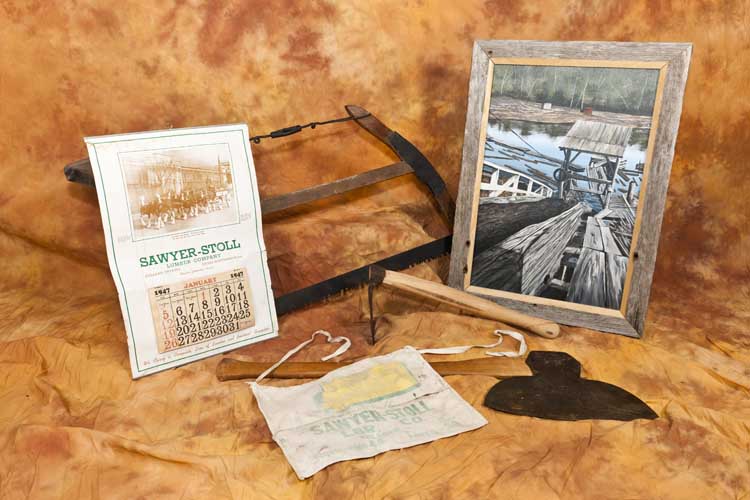
Between the Wars (1920-1940)Jackladder at Sawyer Stoll |
|||
|
|||
Artifacts from the timber industry's second boom in the 1920s |
Timbering opened up the northern part of Lennox and Addington County. According to the local history book The Oxen and The Axe, " there was squared timber cut in Anglesea Township on the west side of Cloyne as early as the 1820s." Competition for limits, or areas to be cut, was fierce, with crews following the spotters who scoured the limit for the tallest, straightest white pines in the forest. The destination for the timber was England only, as the colonies were not allowed trade with any other country. DISCOVER MORE![]()
Using water routes from the Madawaska to the Mazinaw, the Skootamatta to the Moira, timber crews cut trees all winter, piling them by the waterways in time for the spring floods, when giant log booms travelled the routes, eventually ending up in Ottawa or Trenton for sale and shipment. Competing companies would sometimes find themselves at the same place on a river at the same time, and fights would break out among the men. This was not an occupation for the weak at heart! By the late 1800s however, much of the best timber had been cut and the big companies pulled out, leaving behind a trail of destruction, slash and fire.
By the 1920s and 30s some of the forest had rejuvenated and lumbering again became more viable. This composite photo shows a small crosscut ("buck") saw, a broad axe, a painting by local artist Carol Brown of the jackladder at Sawyer Stoll Lumber mill, as well as a shingle maker, a carpenter's apron and a calendar from Sawyer Stoll.
Originally from Michigan, the Sawyer-Stoll Lumber Company set up business north and west of Lake Mazinaw in 1939, providing employment and housing for many many workers in the area. Managed by Wallace Johnson, it proved to be a very successful operation, even after the mill was shut down. The business was moved to Kaladar to take advantage of the readily available trains, and then to Tweed after train travel was discontinued in the 1970s.
Many small companies currently operate in the same trade today, although their equipment and techniques would seem very strange to that of first generation of cutters in our forests.
Submitted courtesy of The Pioneer Museum, Cloyne and District Historical Society, Cloyne
© Lennox & Addington County Museum & Archives
97 Thomas Street East, Napanee, Ontario, Canada K7R 4B9
Funding provided by the Government of Ontario and the County of Lennox & Addington




